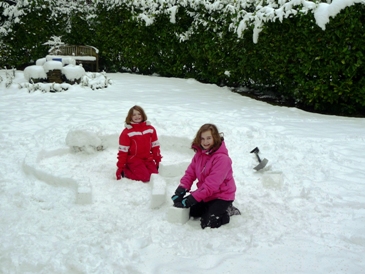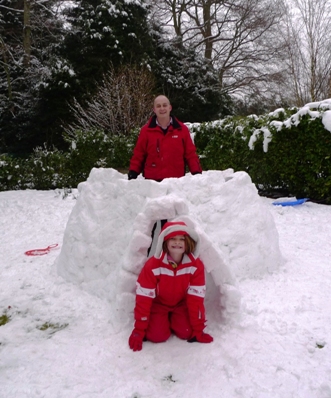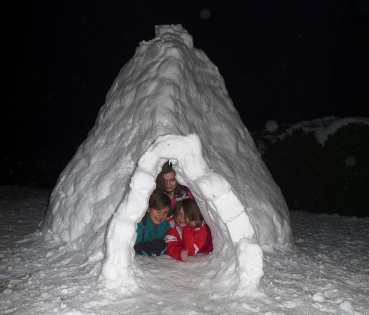With the schools snowbound and closed for a few extra days last month, I persuaded my daughters to help me make an igloo. It’s something I’ve always wanted to do. It took a lot longer than I thought and the pretence that this was “Dad helping them” began to slip after a while as and my co-labourers needed a hot chocolate break or two along the way. I improvised with Tupperware boxes to make my bricks, learned as I went, and bullied/bribed my girls to hold up the walls when we got to the tricky bits. Getting the final block in the roof was an act of sheer desperation and good fortune. We made it! Not quite the classical dome shape, I’ll admit, but it lasted the night before a surprise skylight window appeared the following morning, quickly followed by total collapse. You would think that after 41 years of waiting for that perfect snow, I would have known exactly how to make an igloo; but I didn’t.There is no shortage of material, videos and step-by-step instructions on the web . A Google search on “how to build an igloo” yields 673,000 results, including some excellent step-by-step videos on YouTube. If I’d bothered to look at even the first two of these, then I would have known that the whole thing is built as a self-supporting spiral. After my first layer of snow bricks, I should have cut a shallow incline up the wall to create the beginning of my spiral; but I didn’t.
No, Google and YouTube didn’t let me down. The fact is, I just wanted to get out there with my brick-making and build.
It took a lot longer than I thought and the pretence that this was “Dad helping them” began to slip after a while as and my co-labourers needed a hot chocolate break or two along the way. I improvised with Tupperware boxes to make my bricks, learned as I went, and bullied/bribed my girls to hold up the walls when we got to the tricky bits. Getting the final block in the roof was an act of sheer desperation and good fortune. We made it! Not quite the classical dome shape, I’ll admit, but it lasted the night before a surprise skylight window appeared the following morning, quickly followed by total collapse. You would think that after 41 years of waiting for that perfect snow, I would have known exactly how to make an igloo; but I didn’t.There is no shortage of material, videos and step-by-step instructions on the web . A Google search on “how to build an igloo” yields 673,000 results, including some excellent step-by-step videos on YouTube. If I’d bothered to look at even the first two of these, then I would have known that the whole thing is built as a self-supporting spiral. After my first layer of snow bricks, I should have cut a shallow incline up the wall to create the beginning of my spiral; but I didn’t.
No, Google and YouTube didn’t let me down. The fact is, I just wanted to get out there with my brick-making and build.
 All traces of the igloo have now melted away, but I’m left reflecting on the way I approached the challenge. How often in an organizational situation do we get carried away with misplaced self-belief, a little (but not enough) knowledge, a little too much ego and an eager desire to just roll up our sleeves and get on with it? How often do we deliver something that looks roughly right, but like my igloo, doesn’t withstand the test of time?
All traces of the igloo have now melted away, but I’m left reflecting on the way I approached the challenge. How often in an organizational situation do we get carried away with misplaced self-belief, a little (but not enough) knowledge, a little too much ego and an eager desire to just roll up our sleeves and get on with it? How often do we deliver something that looks roughly right, but like my igloo, doesn’t withstand the test of time?
As knowledge professionals, it’s easy to sink time and money into making content more easily accessible, navigable, and searchable. We can construct elegant wikis, enliven our intranets with RSS and real-time twitter feeds, but none of this will guarantee a better outcome when people have their “igloo moments”. Sometimes, it’s not because people lack access to the knowledge or the time to find it. Rather it’s because they just want to get out there and try it their own way – because it’s something they’ve always wanted to.
So what might have caused me to build my igloo better?
Perhaps a friend out there with me in the garden that day, saying – “Hey, I’ve tried this before. If you want it to last, then need to build it this way...” A challenge for better performance from someone I trusted, and the benefit of their first-hand experience exactly at the moment I needed it. Now that’s a pretty good vision for a knowledgeable, learning organization.
Finally, just to prove that my jokes are no better than my igloo-building skills...
One Eskimo enviously asks another Eskimo: “Which book did you read to find out how to build such a perfect igloo?” The other Eskimo replies:
